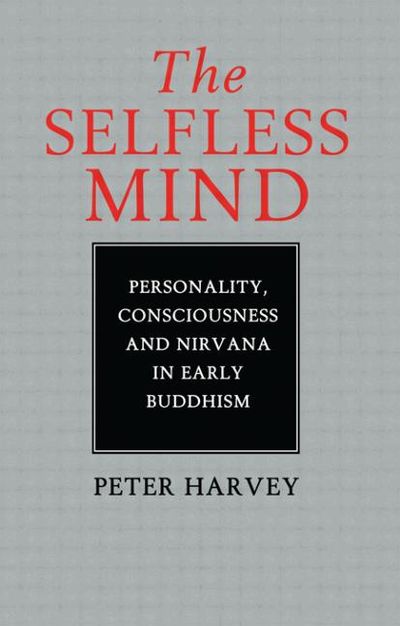No edit summary |
No edit summary |
||
| (8 intermediate revisions by the same user not shown) | |||
| Line 83: | Line 83: | ||
*{{i| ''The activity of discernment (viññāṇa)''|143}} | *{{i| ''The activity of discernment (viññāṇa)''|143}} | ||
*{{i| ''The functions of discernment in the Abhidhamma 'process of cittas'''|145}} | *{{i| ''The functions of discernment in the Abhidhamma 'process of cittas'''|145}} | ||
*{{i| The nature of viññāṇa''|148}} | *{{i| ''The nature of viññāṇa''|148}} | ||
*{{i| ''The effect of karma on discernment in the perceptual process''|151}} | *{{i| ''The effect of karma on discernment in the perceptual process''|151}} | ||
<br> | <br> | ||
10 | *{{i|10 BHAVAṄGA AND. THE BRlGHTLY SHINING MIND|155}} | ||
Is the | *{{i| ''Is the bhavaṅga concept ruled out by the 'early Sutta' world-view?''|155}} | ||
Sutta' world-view? 155 | *{{i| '''Early Sutta' evidence for a bhavaṅga-type state''|151}} | ||
'Early Sutta' evidence for a | *{{i| ''The meaning of 'bhavaṅga'''|160}} | ||
The meaning of ' | *{{i| ''The roles of bhavaṅga''|162}} | ||
The roles of | *{{i| ''The brightly shining citta''|166}} | ||
The brightly shining citta 166 | *{{i| ''Freedom from defilements''|169}} | ||
Freedom from defilements 169 | *{{i| ''The shining citta and bhavaṅga''|170}} | ||
The shining citta and | *{{i| ''The Arahat's ever-shining citta''|173}} | ||
The Arahat's ever-shining citta 173 | *{{i| ''The shining citta and the Buddha-nature''| 114}} | ||
The shining citta and the Buddha-nature 114 | *{{i| ''The shining citta and the realms of rebirth''| 111}} | ||
The shining citta and the realms of rebirth 111 | <br> | ||
*{{i|11 NIBBĀNA AS THE TIMELESS 'STOPPING' OF THE ENTIRE<br> PERSONALITY|180}} | |||
*{{i| ''The nibbāna-element without remainder of upādi''|181}} | |||
*{{i| ''Nibbāna during life as not ever-present in the Arahat''|182}} | |||
*{{i| ''The 'stopping' of the personality-factors during life''|185}} | |||
*{{i| ''Nibbānic 'stopping' and nirodha-samāpatti''| 187}} | |||
*{{i| ''Re-entry to the state of 'stopping'''|188}} | |||
*{{i| ''Nibbāna during life as 'unborn', 'unconstructed' and 'deathless'''|189}} | |||
*{{i| ''Nibbāna as a timeless object of insight''|193}} | |||
<br> | |||
*{{i|12 NIBBĀNA AS A TRANSFORMED STATE OF DISCERNMENT|198}} | |||
*{{i| ''Nibbāna as a form of discernment''|199}} | |||
*{{i| ''Nibbānic discernment as 'stopped', 'objectless' and 'unsupported'''|201}} | |||
*{{i| ''Udāna.80 as a description of nibbānic discernment''|203}} | |||
*{{i| ''The nature of nibbānic discernment''|205}} | |||
*{{i| ''Unsupported discernment and nibbāna beyond death''|208}} | |||
*{{i| ''The relation of nibbānic discernment to the Arahat's normal state''|210}} | |||
*{{i| ''Theravādin perspectives''|214}} | |||
*{{i| ''Mahāyāna perspectives''|217}} | |||
<br> | |||
*{{i|13 SEEKING THE TATHĀGATA|227}} | |||
*{{i| ''The 'untraceability' of the tathāgata''|228}} | |||
*{{i| ''The 'hard to fathom' tathāgata and Dhamma''|231}} | |||
*{{i| ''The tathāgata as 'not being apprehended'''|235}} | |||
*{{i| ''Nibbānic discernment and the views on the tathāgata after death''|239}} | |||
<br> | |||
*{{i|14 CONCLUSION|246}} | |||
<br> | |||
*{{i| ''Appendix: The Theory of the Process of Cittas''|252}} | |||
<br> | |||
*{{i| ''Notes''|259}} | |||
*{{i| ''Abbreviations''|274}} | |||
*{{i| ''Bibliography''|277}} | |||
*{{i| ''Index and glossary''|282}} | |||
<br> | |||
*Charts | |||
*{{i|1. ''The 'process of cittas' in waking consciousness, according to Abhidhamma theory''|146}} | |||
*{{i|2. ''The citta-sequence in sleep''|163}} | |||
*{{i|3. ''The citta-sequence in meditative jhānas''|163}} | |||
|AddRelatedTab=No | |AddRelatedTab=No | ||
|PublisherLogo=File:Routledge logo.png | |||
|StopPersonRedirects=No | |||
}} | }} | ||
Latest revision as of 11:28, 14 September 2020
This careful analysis of early Buddhist thought opens out a perspective in which no permanent Self is accepted, but a rich analysis of changing and potent mental processes is developed. It explores issues relating to the not-Self teaching: self-development, moral responsibility, the between-lives period, and the 'undetermined questions' on the world, on the 'life principle' and on the liberated one after death. It examines the 'person' as a flowing continuity centered on consciousness or discernment (vinnana) configured in changing minds-sets (cittas). The resting state of this is seen as 'brightly shining' - like the 'Buddha nature' of Mahayana thought - so as to represent the potential for Nirvana. Nirvana is then shown to be a state in which consciousness transcends all objects, and thus participates in a timeless, unconditioned realm. (Source: Routledge)
See especially chapter 10, Bhavaṅga and the Brightly Shining Mind.
| Citation | Harvey, Peter. The Selfless Mind: Personality, Consciousness and Nirvāṇa in Early Buddhism. London: RoutledgeCurzon, 2004. First published 1995 by Curzon Press. http://www.ahandfulofleaves.org/documents/The%20Selfless%20Mind_Personality_Consciousness%20and%20Nirvana%20in%20Early%20Buddhism_Harvey_1995-2004r.pdf. |
|---|---|


